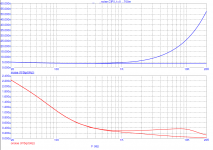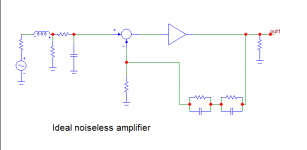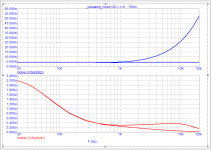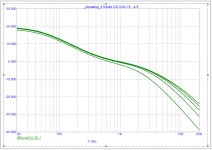One can see that noise resulting from cartridge inductance is dominating at middle and high frequencies and can't be improved by lower noise design.
That doesn't make sense to me: inductance is reactive and doesn't produce any thermal noise. The noise increase with a cartridge connected must be due to a combination of the iron and other losses of the cartridge and the noise of the input termination resistors of the amplifier, which you could replace with an electronically cooled version if you like.
That doesn't make sense to me: inductance is reactive and doesn't produce any thermal noise. The noise increase with a cartridge connected must be due to a combination of the iron and other losses of the cartridge and the noise of the input termination resistors of the amplifier, which you could replace with an electronically cooled version if you like.
Sorry but it is the inductive impedance magnitude in parallel with 47k input resistor that makes the noise. Please let's not speculate about iron losses, if you put the circuit into Microcap you get the same noise rise. And Microcap knows nothing about iron losses in the ideal inductor used for the simulation.
Attachments
Fair enough; many years ago an acquaintance of mine measured the impedance magnitude and phase of a Shure V15-III cartridge and found a considerable increase in the ESR over frequency, but that's a different cartridge than you are using.
In any case, your statement that the noise is due to the cartridge and can't be improved by lower noise design is then plain wrong. It's the termination resistor that causes the noise and it could be replaced with an electronically cooled resistance if you wanted to (which you don't, which is fine of course, but that's your choice rather than a physical limit).
In any case, your statement that the noise is due to the cartridge and can't be improved by lower noise design is then plain wrong. It's the termination resistor that causes the noise and it could be replaced with an electronically cooled resistance if you wanted to (which you don't, which is fine of course, but that's your choice rather than a physical limit).
Re-measured for you in dBV/sqrt(Hz), PSD. To get input noise, please consider that 1kHz gain is 36dB. The soundcard with considerably lower noise was used for this measurements, so the RMS value for 50 ohm has improved a bit.
One can see that noise resulting from cartridge inductance is dominating at middle and high frequencies and can't be improved by lower noise design. Last but not least, real life noise is determined by empty groove noise and is at least 20dB higher than the preamp noise, so the fight for lowest noise design does not make much sense.
This is more in line with what I’m getting - your spot noise floor numbers are better. I get c. -124 to -127 dBV with the input to the pre shorted at 1 kHz and get -75 dB ref 5 mV with a 1350 Ohm plus 500 mH inductance shunting 47k.
(Measurements with QA401 48 kHz 50 averages and 1.46 Hz resolution).
In any case, your statement that the noise is due to the cartridge and can't be improved by lower noise design is then plain wrong. It's the termination resistor that causes the noise and it could be replaced with an electronically cooled resistance if you wanted to (which you don't, which is fine of course, but that's your choice rather than a physical limit).
Yes that's correct, but as long as 47kohm is a recommended load value for the MM cartridge my statement is right. To demonstrate, there is the same circuit with MM cartridge simulated impedance and ideal noiseless amplifier used. The results are just same as with the real amp. So, with an usual MM cartridge and 47k recommended load resistance, circuit design cannot improve the intrinsic noise. It can make it worse, if the design is poor, but there is almost no chance to get worse than empty groove residual noise. So we have nice toys with almost no real life impact on "sound quality".
Attachments
This is more in line with what I’m getting - your spot noise floor numbers are better. I get c. -124 to -127 dBV with the input to the pre shorted at 1 kHz and get -75 dB ref 5 mV with a 1350 Ohm plus 500 mH inductance shunting 47k.
(Measurements with QA401 48 kHz 50 averages and 1.46 Hz resolution).
Thanks for your input, Chris.
Yes that's correct, but as long as 47kohm is a recommended load value for the MM cartridge my statement is right. To demonstrate, there is the same circuit with MM cartridge simulated impedance and ideal noiseless amplifier used. The results are just same as with the real amp. So, with an usual MM cartridge and 47k recommended load resistance, circuit design cannot improve the intrinsic noise. It can make it worse, if the design is poor, but there is almost no chance to get worse than empty groove residual noise. So we have nice toys with almost no real life impact on "sound quality".
I gather you are not familiar with electronic cooling. When you make an amplifier with a gain of -A and put a resistor of A + 1 times 47 kohm between its input and output, you have effectively made a 47 kohm resistor to ground, but with ideally an A + 1 times smaller noise power spectral density. It's a very common technique in RF design and it has been known since 1939, but you don't see it much in audio.
By the way, Elektor published a moving-magnet amplifier a couple of years ago that's so poor that its noise is substantial compared to record surface noise. It's called the Supra 2.0 and uses four paralleled LT1028s.
Not really... Let's just not forget that RIAA and NAB equalization are actually mild compander expander systems and the SNR is different when playing RIAA encoded music through the RIAA network than when playing nothing but an empty groove without equalization.You are absolutely correct, Bill. Real life LP may have S/N up to 60dB(A) and this is sometimes better than tape hiss (without Dolby A) and mike preamp noise. Depends.
Does vinyl suffer from low signal-to-noise ratio ? | Page 9 | Steve Hoffman Music Forums
GREAT SOUNDING RECORDS
And there's also the CX encoding that never took off but maybe it will if some recording company may decide to revive it.
CX (audio) - Wikipedia
Yes that's correct, but as long as 47kohm is a recommended load value for the MM cartridge my statement is right.
I must admit to exploring non recommended loads based on some measurements Hans has done. No conclusions yet though.
Changing the 47k load resistance of the MM cartridge significantly changes the frequency response. Remember that MM lumped impedance is a series combination of the resistor and the inductor. This loaded by recommended 47k. If you change the 47k to something else, you get different frequency response of the Rs-Ls to Rload divider. Below is the simulation for 1166ohm + 510mH cartridge loaded with 7k to 47k resistance. You would need to change the RIAA EQ feedback values when changing the 47k to something else.
Attachments
Last edited:
The load resistor can be reduced to address peaking. There are some graphs around the forum showing this - the peaking more often than not due to stylus tip resonance than cart L interacting with load capacitance. I’ve tried this with my Ortofon 2 Red and interestingly, you can soften the top a bit.
Funny, with a Denon 103 the top end sounds smoother, but that might just be my ears - no definitive proof.
Funny, with a Denon 103 the top end sounds smoother, but that might just be my ears - no definitive proof.
Nice design...
Pavel, what J-FETS and MOS FETS do you use?
For the J-FETS, LSK486/689 would be obvious, but where to get them in Europe?
Pavel, what J-FETS and MOS FETS do you use?
For the J-FETS, LSK486/689 would be obvious, but where to get them in Europe?
Well there is the possibility to lower the load resistor and to create the 3.18µs time constant with the inductivity of the cartridge.
No idea whether the datasheet information from manufacturers is accurate enough.
Or one has the possibility to use a test record..
I think Bob Cordells phono preamp does it similarly...
No idea whether the datasheet information from manufacturers is accurate enough.
Or one has the possibility to use a test record..
I think Bob Cordells phono preamp does it similarly...
Changing the 47k load resistance of the MM cartridge significantly changes the frequency response. Remember that MM lumped impedance is a series combination of the resistor and the inductor. .
Except the model is a bit more complex than that. Hans and George did some work measuring these and some interesting options came out. But this was around modelling the generator to see if we can measure the mechanical transfer function. Work in progress due to lack of time on my part.
https://www.diyaudio.com/forums/ana...tridge-dynamic-behaviour-144.html#post5792099Except the model is a bit more complex than that. Hans and George did some work measuring these and some interesting options came out. But this was around modelling the generator to see if we can measure the mechanical transfer function. [...]
Sorry I messed up the time constants...
Corrected:
Corrected:
Well there is the possibility to lower the load resistor and to create the 75µs time constant with the inductivity of the cartridge.
No idea whether the datasheet information from manufacturers is accurate enough.
Or one has the possibility to use a test record..
I think Bob Cordells phono preamp does it similarly...
The short answer is no. You have to measure the cart as the specs can be all over the place. Loading down that far also gives a 7dB noise penalty (which cooled loading can claw back for added complexity) so the Cordell approach of putting the L-R pole and 8KHz and a matching zero in the RIAA response seems to be a good half way house.
The big advantage of the Cordell scheme is it takes cable C out the equation, which is the big problem IMO with a lot of phono schemes as you can have 200pF before you even get to the phono stage.
The big advantage of the Cordell scheme is it takes cable C out the equation, which is the big problem IMO with a lot of phono schemes as you can have 200pF before you even get to the phono stage.
I still do not understand the fight for the lowest noise MM preamp, if the real life vinyl groove noise destroys all the possible achievements (the same applies to the so called active damping principle). The real life improvement is zero and I agree, we need to measure the real life situation, however it must include the vinyl source record, otherwise it is just another game toy. I have dozens to hundreds of measurements with real life vinyl records, including the measuring records.
Hobbies do not have to make any sense! It just happens to be phono stages where I allow myself to be silly. The rest of my system is relatively sane.
I thought That Vogel taught you something different ...I actually can't understand why you start defending fiercely one idea in one topic , then claim that all the others who did the same thing must be some clowns in another topic...Doesn't it look like a double standard j-fet application note 🙂 ?I still do not understand the fight for the lowest noise MM preamp, if the real life vinyl groove noise destroys all the possible achievements (the same applies to the so called active damping principle). The real life improvement is zero and I agree, we need to measure the real life situation, however it must include the vinyl source record, otherwise it is just another game toy. I have dozens to hundreds of measurements with real life vinyl records, including the measuring records.
https://www.diyaudio.com/forums/ana...et-vs-bjt-input-phono-preamp.html#post6283024
https://www.diyaudio.com/forums/ana...-vs-bjt-input-phono-preamp-4.html#post6288586
- Home
- Source & Line
- Analogue Source
- JFET input phono preamp for MM



